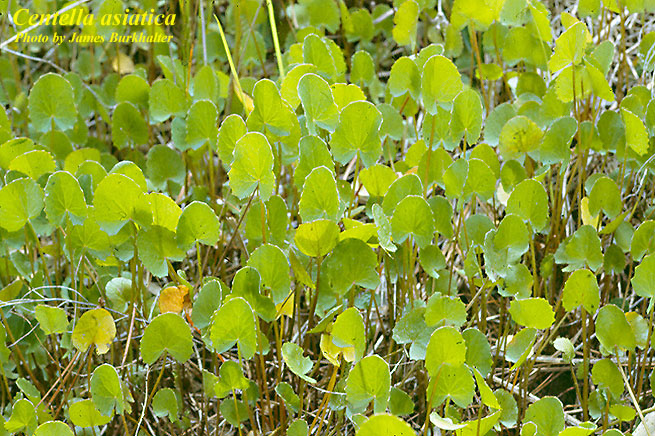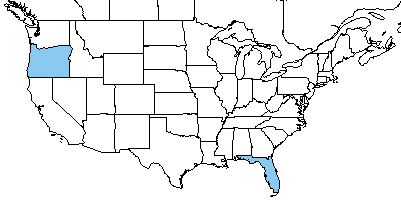Difference between revisions of "Centella asiatica"
(→Ecology) |
(→Ecology) |
||
| Line 40: | Line 40: | ||
<!--===Seed dispersal===--> | <!--===Seed dispersal===--> | ||
<!--===Seed bank and germination===--> | <!--===Seed bank and germination===--> | ||
| − | + | ||
| + | ===Fire ecology=== <!--Fire tolerance, fire dependence, adaptive fire responses--> | ||
| + | A study found ''C. asiatica'' to significantly increase in frequency in response to multiple disturbances, including burning, clearcutting, stump removal, shearing and piling, and discing in north Florida.<ref name= "Conde">Conde, L. F., et al. (1983). "Plant species cover, frequency, and biomass: Early responses to clearcutting, burning, windrowing, discing, and bedding in Pinus elliottii flatwoods." Forest Ecology and Management 6: 319-331.</ref> | ||
<!--===Pollination===--> | <!--===Pollination===--> | ||
Revision as of 12:57, 4 April 2019
Common name: Spadeleaf [1]; Centella [2]; Coinleaf [2]
| Centella asiatica | |
|---|---|

| |
| Photo by the Atlas of Florida Plants Database | |
| Scientific classification | |
| Kingdom: | Plantae |
| Division: | Magnoliophyta - Flowering plants |
| Class: | Magnoliopsida - Dicots |
| Order: | Apiales |
| Family: | Apiaceae |
| Genus: | Centella |
| Species: | C. asiatica |
| Binomial name | |
| Centella asiatica L. Urb. | |

| |
| Natural range of Centella asiatica from USDA NRCS Plants Database. | |
Contents
[hide]Taxonomic Notes
Synonyms: Centella erecta (Linnaeus f.) Fernald; Centella repanda (Persoon) Small
Varieties: none
Description
C. asiatica is a perennial forb/herb or subshrub of the Apiaceae family native to the Pacific Basin, excluding Hawaii. [1]
Distribution
While native to the Pacific Basin, C. asiatica has been introduced in the United States in Hawaii, Oregon, and Florida.[1]
Ecology
Habitat
C. asiatica is found in savannas, pondshores, ditches, and a wide variety of other moist to wet habitats.[2][3]
Associated species: Xyris isoetifolia, Hypericum lissophloeus, Hypericum sp., Rhexia salicifolia, Taxodium distichum, Fraxinus profunda, Quercus laurifolia, Polygala lutea, Pluchea baccharis, Sarracenia flava, and Proserpinaca pinnata.[3]
Phenology
C. asiatica has been observed flowering from April to August as well as September and October.[4][3] It has been observed fruiting in August, October, and November.[3]
Fire ecology
A study found C. asiatica to significantly increase in frequency in response to multiple disturbances, including burning, clearcutting, stump removal, shearing and piling, and discing in north Florida.[5]
Use by animals
In Asia, C. asiatica is a host plant for the false spider mite (Brevipalpus californicus).[6]
Conservation and Management
Cultivation and restoration
Photo Gallery
References and notes
- ↑ Jump up to: 1.0 1.1 1.2 USDA Plant Database https://plants.usda.gov/core/profile?symbol=CEAS
- ↑ Jump up to: 2.0 2.1 2.2 Weakley, A. S. (2015). Flora of the Southern and Mid-Atlantic States. Chapel Hill, NC, University of North Carolina Herbarium.
- ↑ Jump up to: 3.0 3.1 3.2 3.3 URL: http://herbarium.bio.fsu.edu. Last accessed: June 2018. Collectors: Ann F. Johnson, Cecil R. Slaughter, Dianne Hall, Kim Ponzio, Loran C. Anderson, R.F. Doren, Robert K. Godfrey, R. Kral, M. Darst, H. Light, L. Peed. States and counties: Washington County Florida, Indian River County Florida, Brevard County Florida, Gulf County Florida, Wakulla County Florida, Leon County Florida, Thomas County Georgia, Jackson County Florida, Covington County Alabama, Gadsden County Florida, Dixie County Florida.
- Jump up ↑ Nelson, G. PanFlora: Plant data for the eastern United States with emphasis on the Southeastern Coastal Plains, Florida, and the Florida Panhandle. www.gilnelson.com/PanFlora/ Accessed: 18 MAY 2018
- Jump up ↑ Conde, L. F., et al. (1983). "Plant species cover, frequency, and biomass: Early responses to clearcutting, burning, windrowing, discing, and bedding in Pinus elliottii flatwoods." Forest Ecology and Management 6: 319-331.
- Jump up ↑ Childers, C. C., et al. (2003). "Host plants of Brevipalpus californicus, B. obovatus, and B. phoenicis (Acari: Tenuipalpidae) and their potential involvement in the spread of viral diseases vectored by these mites." Experimental & Applied Acarology 30: 29-105.